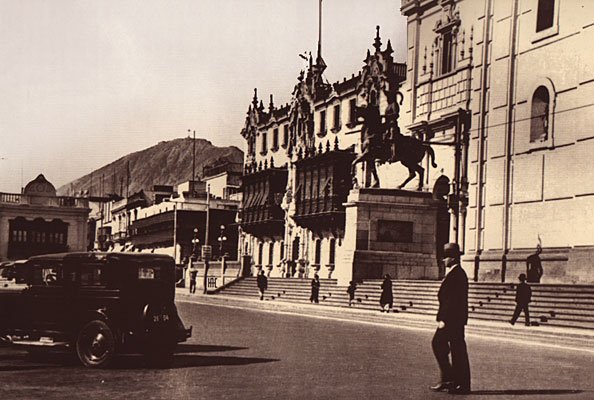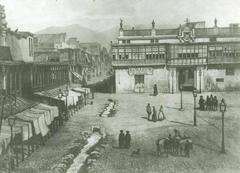
Casa del Oidor Lima, Peru: Visiting Hours, Tickets, and Historical Sites Guide
Date: 15/06/2025
Introduction
Located on Lima’s iconic Plaza Mayor, Casa del Oidor is a landmark of Peru’s colonial past and a vital part of the city’s cultural landscape. Built soon after Francisco Pizarro founded Lima in 1535, this historic residence served as the home and office of the “Oidor”—a senior judicial official of the Royal Audiencia. Today, Casa del Oidor not only preserves centuries of history through its architecture and exhibitions but also welcomes visitors as a dynamic cultural venue. This guide offers comprehensive information on its visiting hours, ticketing, historical context, and practical travel tips for an enriching experience at this emblematic site. (Revista del Archivo General de la Nación; Peru Travel)
Table of Contents
- Historical Significance and Origins
- Architectural Features and Restoration
- Visiting Hours and Ticket Information
- Guided Tours and Special Events
- Accessibility, Facilities, and Travel Tips
- Nearby Attractions in Lima’s Historic Center
- Frequently Asked Questions (FAQ)
- Conclusion and Recommendations
- References
Historical Significance and Origins
Casa del Oidor derives its name from the Spanish colonial “oidor” (judge) who worked in the Royal Audiencia, the highest court of the Viceroyalty of Peru. Its prominent location on Plaza Mayor was a deliberate decision, reflecting the Spanish Crown’s urban planning that placed key administrative buildings at the heart of Lima. Throughout its history, Casa del Oidor has played a central role in the legal and social life of the city, witnessing events ranging from the declaration of independence to modern civic celebrations. (Revista del Archivo General de la Nación; Peru Travel; LimaEasy)
Architectural Features and Restoration
Casa del Oidor exemplifies Lima’s colonial architecture, blending Spanish and Moorish elements with local building techniques. The building is characterized by:
- Thick Adobe Walls and Wooden Beams: Designed for resilience against Lima’s seismic activity.
- Closed Wooden Balconies: These iconic features served both as status symbols and as vantage points for discreet observation of the Plaza Mayor.
- Central Courtyards: Allowing light and ventilation, the courtyards reflect adaptation to Lima’s climate.
- Restoration Efforts: After suffering earthquake damage and facing possible demolition, Casa del Oidor was restored in 1968 as part of larger preservation initiatives. Today, it is a protected monument and an integral part of Lima’s UNESCO World Heritage-listed historic center. (Plan Maestro del Centro Histórico de Lima; UNESCO World Heritage)
Visiting Hours and Ticket Information
- Visiting Hours: Generally open Tuesday to Sunday, 10:00 AM – 6:00 PM. Closed Mondays and public holidays. (Check ahead as hours may vary during special events or renovations.)
- Admission: Entry is typically free, but some exhibitions or events may require tickets or advance registration.
- Museum and Tastings: If visiting the Museo del Pisco inside, entry or tastings range from 20 to 40 PEN.
- Ticket Purchase: Tickets for special exhibitions or events can be bought on-site; some may be available online via the official tourism website.
Guided Tours and Special Events
- Self-Guided Visits: Casa del Oidor features in many walking tours of Lima’s historic center. Informative plaques help visitors understand its significance. (GPSmyCity; Sacavoyage)
- Guided Tours: Occasionally available in Spanish and English through the Museo del Pisco or local tour operators. These provide deeper insights into the architecture and history.
- Cultural Events: The building often hosts art exhibitions, lectures, tastings, and community gatherings. Check Museo del Pisco’s social media or the Municipalidad de Lima for event calendars.
Accessibility, Facilities, and Travel Tips
Facilities
- Accessibility: The ground floor is accessible, but upper floors may present challenges to those with reduced mobility due to historic stairs and uneven surfaces.
- Restrooms: Available for patrons of on-site businesses.
- Dining: Museo del Pisco offers local cuisine and drinks; craft shops are also present.
- Languages: Spanish is predominant; some tours and materials in English.
Getting There
- By Public Transport: Metropolitano bus stops at Jirón de la Unión, a short walk away.
- By Taxi/Rideshare: Uber and other services can drop you at Plaza Mayor.
- On Foot: Easily walkable from major landmarks in the historic center.
Tips
- Best Time to Visit: Morning and early afternoon for fewer crowds; evenings for a vibrant plaza atmosphere.
- Photography: The façade and balconies are popular photo spots. Always ask before photographing indoors.
- Safety: The area is generally safe, but remain vigilant, especially at night or during crowded events.
Nearby Attractions in Lima’s Historic Center
A visit to Casa del Oidor pairs perfectly with other nearby highlights:
- Lima Cathedral: Home to Francisco Pizarro’s tomb.
- Government Palace: Site of the daily changing of the guard.
- Casa de Aliaga: The oldest continuously inhabited house in the Americas.
- San Francisco Monastery: Renowned catacombs and historical library.
- Jirón de la Unión: Lively pedestrian shopping and dining street.
Frequently Asked Questions (FAQ)
Q: What are Casa del Oidor’s visiting hours?
A: Generally open Tuesday to Sunday, 10:00 AM to 6:00 PM; closed Mondays and public holidays.
Q: Is there an entrance fee?
A: Entry is usually free, but some exhibitions or tastings may require tickets.
Q: Are guided tours offered?
A: Occasionally, in Spanish and English. Check with Museo del Pisco or local operators.
Q: Is the building accessible to people with disabilities?
A: Access is limited, especially to upper floors. The ground floor is partially accessible.
Q: Can I take photos inside?
A: The exterior is always open for photography; indoor photography depends on current exhibitions and staff policies.
Q: Which other historic sites are nearby?
A: Lima Cathedral, Government Palace, Casa de Aliaga, and San Francisco Monastery are all within walking distance.
Conclusion and Recommendations
Casa del Oidor is a must-see for anyone interested in Lima’s colonial heritage and contemporary culture. Its blend of historic architecture, evolving community role, and accessibility make it a highlight of the city’s historic center. Visitors are encouraged to check official sources for current hours and events, join a guided or self-guided walking tour, and take advantage of cultural programs that deepen your connection to Lima’s past and present. For the latest updates, follow the Municipalidad de Lima, Museo del Pisco, and the official Lima tourism website.
References
- Revista del Archivo General de la Nación
- LimaEasy
- Evendo Casa del Oidor
- Plan Maestro del Centro Histórico de Lima
- Municipalidad de Lima
- Peru Travel
- UNESCO World Heritage
- GPSmyCity
- Sacavoyage
- Infobae
- Official Lima Tourism Website
Explore Casa del Oidor and discover the stories embedded in Lima’s architecture and urban life. For a deeper dive into the city’s history, consider visiting the other nearby landmarks and engaging with local guides or digital resources for a truly immersive experience. (Lonely Planet)















































































































